August 1, 2016 – Daniel Mitchell, Rachel James, Piers M. Forster, Richard A. Betts, Hideo Shiogama and Myles Allen, researchers from University of Oxford, Leeds, Exeter and the National Institute for Environmental Studies in Japan, have written a commentary and opinion piece on the impacts of a 1.5 Celsius (2.7 Fahrenheit) warmer world and what scientists can currently tell us. They begin with the following:
“The decision on whether to increase the ambition of climate change mitigation efforts to stabilize temperatures at 1.5 C rather than 2 C above pre-industrial levels is arguably one of the most momentous to be made in the coming decade…”
Why is that?
Because when COP21 convened in Paris in late November of last year, the nations of the world came together committed to a 2 Celsius limit. But the meeting also invited the scientific community to prepare a report by 2018 to look at a scenario where 1.5 Celsius was the target warming limit. A plea from Pacific Ocean island nations argued for the lower limit stating that at 2.0 Celsius sea level rises would seriously imperil their existence.
In the commentary which appears in Nature Climate Change, the authors argue that research on a 2 Celsius and even 4 Celsius upper warming limit has been done, but “scientific questions around 1.5 C” remain. They state “it is our job as scientists” to explain to policy makers what the 1.5 C versus 2.0 C scenario means. As they state in their conclusions “for once, we have been asked a very specific question, so we need a very good reason indeed not to step up and answer it.”
Today, policymakers cannot fathom the difference, and therefore, research needs to be done on “the relative impacts of different temperature outcomes before updating their decision on the overall goal in 2020.” That 2020 reference is a milestone date established by COP21 in which all signatories are to provide revised carbon reduction targets.
The authors are calling for “scientifically robust” studies to look at 1.5 Celsius impacts. The examples given include studying the mean global precipitation response to 1.5 Celsius including looking at changes in distribution and timing. This means building simulations that realistically capture a 1.5 Celsius scenario. They call for further experiments and modeling to assess the risk of increasing extreme weather events. They propose high atmospheric studies to understand the equilibrium changes in the atmospheric engine. They propose looking at sea level models in a 1.5 Celsius scenario. At the same time they ask the scientific community to run in parallel similar for 2.0 Celsius.
They argue this is “a matter of urgency….that the 2018 special report will present all the negative economic constraints of achieving 1.5 C but with insufficient evidence to distinguish between impacts at 1.5 C and 2 C of warming.”
The ditch the 2.0 Celsius movement for a 1.5 Celsius limit began well before COP21. In fact the 2.0 upper limit has always been an artificial construct that got first mention in the 1960s and 70s. At that time a doubling of atmospheric CO2 was equated with a temperature rise of 2.0 Celsius. And as the United Nations and its members began to look at the serious implications of climate change and global warming the 2.0 Celsius limit got embedded in the conversation.
But in 2013 15 Pacific Ocean states including Australia and New Zealand signed the Majuro Declaration that pointed to the survival risk for many of the declaration’s signatories based on inaction by governments across the planet. The Maldive Islands in the Indian Ocean, prior to COP21, reflected a common concern with the Pacific Majuro signatories.
Nowhere in the opinion piece described above is there a reference to tipping point deltas under a 1.5 or 2.0 Celsius future. This appears to be an oversight. Because tipping points represent the unknown factor associated with global warming and there are many places on the planet where local impacts may differ dramatically when the difference is 0.5 Celsius.
I refer to a recent published paper appearing in the journal Earth System Dynamics which I wrote about back in April of this year. The authors of this research provide a infographic comparing the two scenarios on a global scale. But they also specifically describe the impact of the 0.5 Celsius difference on specific regions of the planet.
This is only one paper and the call for many more research projects like this is very much needed. In that I concur with this latest opinion and commentary.
What should be studied?
In a paper that appeared in PNAS last year discussing the implications of a 2.0 Celsius rise, 37 tipping points were identified of which 18 were expected to happen at less than 2.0 Celsius. These 18 include studies of particular interest to Canada, Alaska, the Scandinavian countries and Russia, countries which will feel the exaggerated impact of the 0.5 Celsius delta when translated to polar regions.









